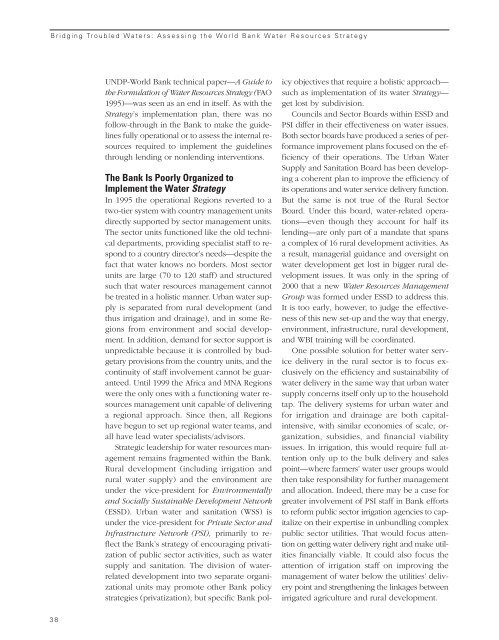Download Report - Independent Evaluation Group - World Bank
Download Report - Independent Evaluation Group - World Bank
Download Report - Independent Evaluation Group - World Bank
You also want an ePaper? Increase the reach of your titles
YUMPU automatically turns print PDFs into web optimized ePapers that Google loves.
Bridging Troubled Waters: Assessing the <strong>World</strong> <strong>Bank</strong> Water Resources StrategyUNDP-<strong>World</strong> <strong>Bank</strong> technical paper—A Guide tothe Formulation of Water Resources Strategy (FAO1995)—was seen as an end in itself. As with theStrategy’s implementation plan, there was nofollow-through in the <strong>Bank</strong> to make the guidelinesfully operational or to assess the internal resourcesrequired to implement the guidelinesthrough lending or nonlending interventions.The <strong>Bank</strong> Is Poorly Organized toImplement the Water StrategyIn 1995 the operational Regions reverted to atwo-tier system with country management unitsdirectly supported by sector management units.The sector units functioned like the old technicaldepartments, providing specialist staff to respondto a country director’s needs—despite thefact that water knows no borders. Most sectorunits are large (70 to 120 staff) and structuredsuch that water resources management cannotbe treated in a holistic manner. Urban water supplyis separated from rural development (andthus irrigation and drainage), and in some Regionsfrom environment and social development.In addition, demand for sector support isunpredictable because it is controlled by budgetaryprovisions from the country units, and thecontinuity of staff involvement cannot be guaranteed.Until 1999 the Africa and MNA Regionswere the only ones with a functioning water resourcesmanagement unit capable of deliveringa regional approach. Since then, all Regionshave begun to set up regional water teams, andall have lead water specialists/advisors.Strategic leadership for water resources managementremains fragmented within the <strong>Bank</strong>.Rural development (including irrigation andrural water supply) and the environment areunder the vice-president for Environmentallyand Socially Sustainable Development Network(ESSD). Urban water and sanitation (WSS) isunder the vice-president for Private Sector andInfrastructure Network (PSI), primarily to reflectthe <strong>Bank</strong>’s strategy of encouraging privatizationof public sector activities, such as watersupply and sanitation. The division of waterrelateddevelopment into two separate organizationalunits may promote other <strong>Bank</strong> policystrategies (privatization), but specific <strong>Bank</strong> policyobjectives that require a holistic approach—such as implementation of its water Strategy—get lost by subdivision.Councils and Sector Boards within ESSD andPSI differ in their effectiveness on water issues.Both sector boards have produced a series of performanceimprovement plans focused on the efficiencyof their operations. The Urban WaterSupply and Sanitation Board has been developinga coherent plan to improve the efficiency ofits operations and water service delivery function.But the same is not true of the Rural SectorBoard. Under this board, water-related operations—eventhough they account for half itslending—are only part of a mandate that spansa complex of 16 rural development activities. Asa result, managerial guidance and oversight onwater development get lost in bigger rural developmentissues. It was only in the spring of2000 that a new Water Resources Management<strong>Group</strong> was formed under ESSD to address this.It is too early, however, to judge the effectivenessof this new set-up and the way that energy,environment, infrastructure, rural development,and WBI training will be coordinated.One possible solution for better water servicedelivery in the rural sector is to focus exclusivelyon the efficiency and sustainability ofwater delivery in the same way that urban watersupply concerns itself only up to the householdtap. The delivery systems for urban water andfor irrigation and drainage are both capitalintensive,with similar economies of scale, organization,subsidies, and financial viabilityissues. In irrigation, this would require full attentiononly up to the bulk delivery and salespoint—where farmers’ water user groups wouldthen take responsibility for further managementand allocation. Indeed, there may be a case forgreater involvement of PSI staff in <strong>Bank</strong> effortsto reform public sector irrigation agencies to capitalizeon their expertise in unbundling complexpublic sector utilities. That would focus attentionon getting water delivery right and make utilitiesfinancially viable. It could also focus theattention of irrigation staff on improving themanagement of water below the utilities’ deliverypoint and strengthening the linkages betweenirrigated agriculture and rural development.38
















